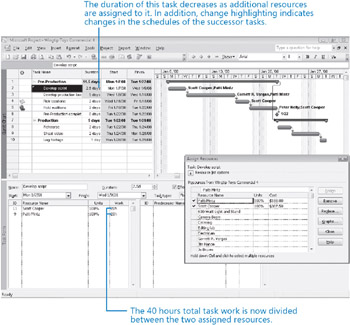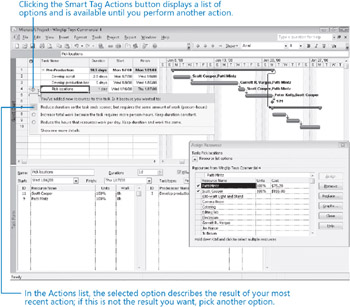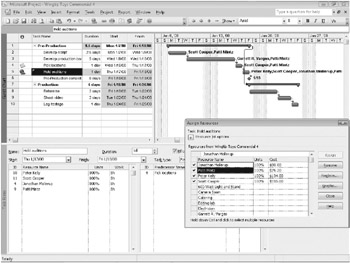Assigning Additional Resources to a Task
Now you will assign additional resources to some of the pre-production tasks to observe the effect on the overall duration of the tasks. By default, Project uses a scheduling method called effort-driven scheduling. This means that the task’s initial work value, or amount of effort, remains constant regardless of the number of resources you assign. The most visible effect of effort-driven scheduling is that, as you assign additional resources to a task, that task’s duration decreases. Project applies effort-driven scheduling only when you assign resources to or remove resources from tasks.
As you saw previously, you define the amount of work that a task represents when you initially assign a resource or resources to it. If you later add resources to that task with effort-driven scheduling turned on, the amount of work for the task does not change, but the task’s duration decreases. Or you might initially assign more than one resource to a task and later remove one of those resources. When effort-driven scheduling is used, the amount of work for the task stays constant; however, its duration, or time it takes the remaining resource to complete that task, increases.
| Tip | By default, effort-driven scheduling is enabled for all tasks you create in Project. To change the default setting for all new tasks in a project plan, on the Tools menu, click Options, and in the Options dialog box, click the Schedule tab. Select or clear the New tasks are effort-driven check box. To control effort-driven scheduling for a specific task or tasks, first select the task or tasks. Then on the Project menu, click Task Information, and on the Advanced tab of the Task Information dialog box, select or clear the Effort driven check box. |
In this exercise, you assign additional resources to tasks and observe how this affects task durations.
1. In the Gantt Chart view, click the name of task 2, Develop script.
Currently, Scott Cooper is assigned to this task. A quick check of the scheduling formula looks like this:
![]()
You can see these values in the Task Form.
Next, you will assign a second resource to the task.
2. In the Resource Name column in the Assign Resources dialog box, click Patti Mintz, and click Assign.
Patti Mintz is assigned to task 2.

As you can see, Project reduced the duration of task 2 from 5 days to 2.5 days. Why? The total work required is still 40 hours, as it was when only Scott was assigned to the task, but now the work is distributed evenly between Scott and Patti at 20 hours apiece. This demonstrates how effort-driven scheduling works. If you add resources to a task after an initial assignment, the total work remains constant but is distributed among the assigned resources. Furthermore, the task’s duration decreases accordingly.
The scheduling formula now looks like this:
![]()
The 200% assignment units is the sum of Scott’s 100% plus Patti’s 100%, and the 40 work hours is the sum of Scott’s 20 hours plus Patti’s 20 hours.
The other important effect of reducing the duration of task 2 is that the start dates of all successor tasks have changed as well. The change highlighting that is now visible throughout the project illustrates the changes to successor tasks. In Chapter 2, you created task relationships, or links, for these tasks. In our current example, you see the benefit of creating task relationships rather than entering fixed start and finish dates. Project adjusts the start dates of successor tasks that do not have a constraint, such as a fixed start or finish date.
Next, you use a feature called a Smart Tag to control how Project schedules the work on a task when assigning multiple resources.
3. In the Gantt Chart view, click the name of task 4, Pick locations.
Currently, only Scott Cooper is assigned to this two-day task. You’d like to assign an additional resource and reduce the task’s duration to one day.
4. In the Resource Name column of the Assign Resources dialog box, click Patti Mintz, and then click Assign.
Patti Mintz is also assigned to task 4.
Note the small triangle in the upper left corner of the name of task 4. This is a graphical indicator that a Smart Tag is now available. Until you perform another action, you can use the Smart Tag to choose how you want Project to handle the additional resource assignment.
5. Click the name of task 4, and then click the Smart Tag Actions button that appears just to the left of the task name. ![]()
Look over the options on the list that appears.

These options allow you to choose the scheduling result you want if it should differ from the effort-driven scheduling result. You can adjust the task’s duration, the resource’s work, or the assignment units.
For this task, you want the additional resource assignment to reduce the task’s duration. Because this is the default setting on the Smart Tag Actions list, you don’t need to make any changes.
6. Click the Smart Tag Actions button again to close the list.
| Tip | You will see other Smart Tag indicators while using Project. They generally appear when you might otherwise ask yourself, “Hmm, why did Project just do that?” (such as when a task’s duration changes after you assign an additional resource). The Smart Tag Actions list gives you the chance to change how Project responds to your actions. |
To conclude this exercise, you will assign additional resources to a task and change how Project schedules the work on the task.
7. In the Gantt Chart view, click the name of task 5, Hold auditions.
8. In the Resource Name column of the Assign Resources dialog box, click Jonathan Mollerup, hold down the ![]() key, click Patti Mintz, and then click Assign.
key, click Patti Mintz, and then click Assign.
Project assigns Jonathan and Patti to the task. Because effort-driven scheduling is turned on for this task, Project reduces the duration of the task and adjusts the start dates of all successor tasks.

However, this time you do not want the additional resource assignments to change the task’s duration. Jonathan and Patti will perform additional work on the task beyond the scope of the task’s original work, which was assigned to Peter and Scott.
9. Click the name of task 5, and then click the Smart Tag Actions button when it appears.
10. On the Smart Tag Actions list, select the option Increase total work because the task requires more person-hours. Keep duration constant.
Project changes the task’s duration back to two days and adjusts the start dates of all successor tasks. The additional resources receive the same work values (16 hours per resource) that the initially assigned resources had received, so total work on the task increases.

| Tip | If you initially assign two resources to a task with a duration of three days (equal to 24 hours), Project schedules each resource to work 24 hours for a total of 48 hours of work on the task. However, you might initially assign one resource to a task with a duration of 24 hours and later add a second resource. In this case, effort-driven scheduling will cause Project to schedule each resource to work 12 hours in parallel for a total of 24 hours of work on the task. Remember that effort-driven scheduling adjusts task duration only if you add or delete resources from a task. |
11. On the Window menu, click Remove Split.
Project hides the Task Form.
You should consider the extent to which effort-driven scheduling should apply to the tasks in your projects. For example, if one resource should take 10 hours to complete a task, could 10 resources complete the task in one hour? How about 20 resources in 30 minutes? Probably not; the resources would likely get in each other’s way and require additional coordination to complete the task. If the task is very complicated, it might require significant ramp-up time before a resource could contribute fully. Overall productivity might even decrease if you assign more resources to the task.
No single rule exists about when you should apply effort-driven scheduling and when you should not. As the project manager, you should analyze the nature of the work required for each task in your project and use your best judgment.
EAN: 2147483647
Pages: 247